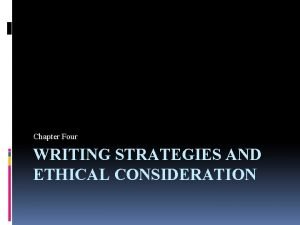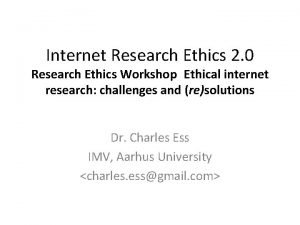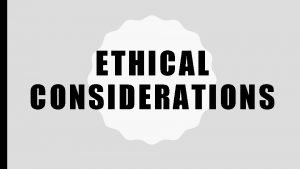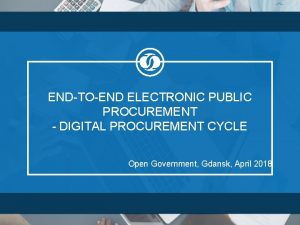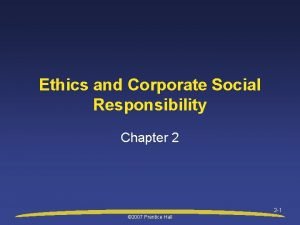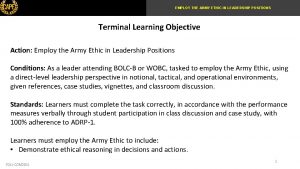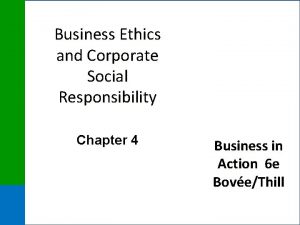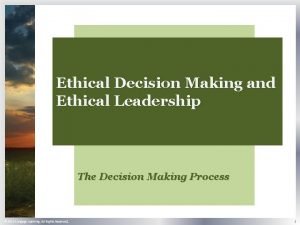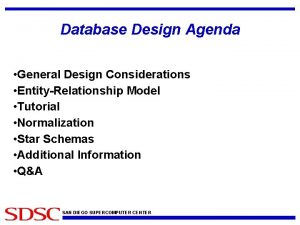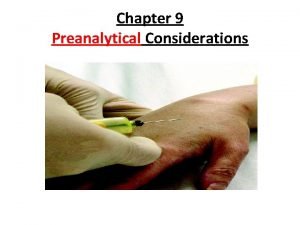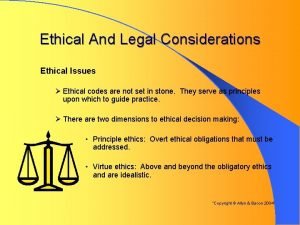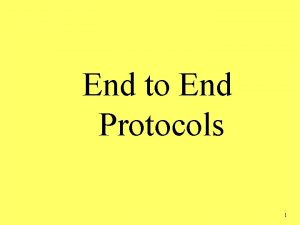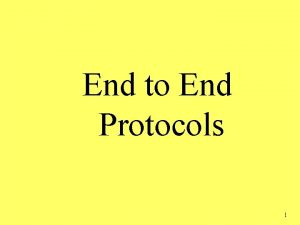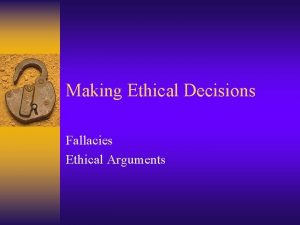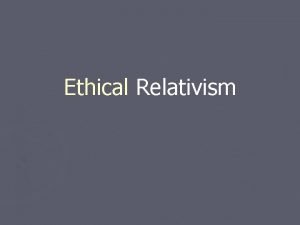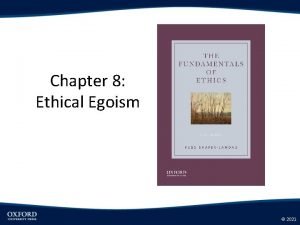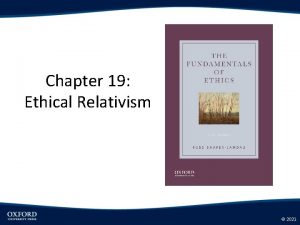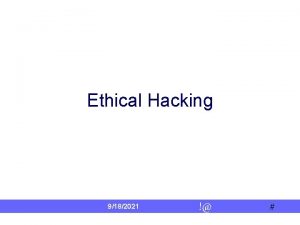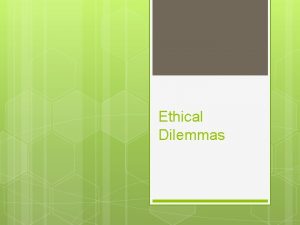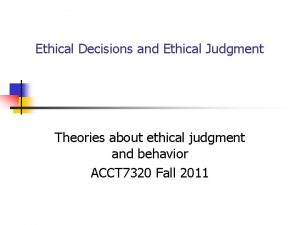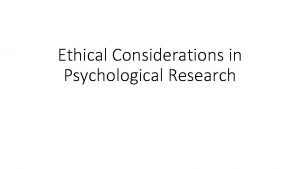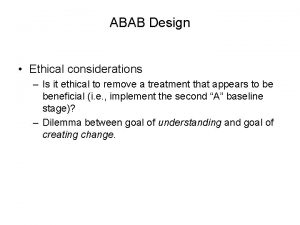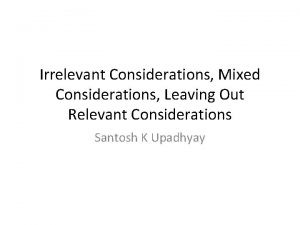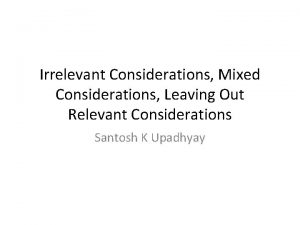Ethical Considerations Near the End of Life Fr























- Slides: 23

Ethical Considerations Near the End of Life Fr. Tom Knoblach, Ph. D Consultant for Healthcare Ethics Diocese of Saint Cloud

A Bit of Context … n n n “What can we do? ” – the medical options “What should we do? ” – the ethical decisions Ethics does not provide the answers to the appropriate use of technology and choice of interventions, but it helps us to ask the right questions

n It is worth remembering that: most cases are not ethically problematic – good decisions are made in the right way q “hard cases make bad ethics” – limit cases can test our assumptions, but ethics is not restricted to dilemmas and crises q many difficulties arise not so much out of ethical uncertainty as out of lack of clear communication and shared understanding q

What Impacts the Process? n n Historical and technological developments – e. g. , dialysis and “God squads”; organ transplantation; forms of tube feeding; implantable devices … Court cases – e. g. Quinlan, Conroy, Cruzan, Schiavo … Advocacy for euthanasia and assisted suicide – Hemlock Society, Kevorkian, Quill, Maynard … Escalating health care costs; concerns about cost containment

n Concerns with various inequities in health care provision – by race, gender, age, diagnosis … n Shifting values – paternalism, autonomy, beneficence; consensus; family-centered care; shared decision-making … n Changes in delivery system – in institutions, in specializations, in financial structures, in quality measures, in regulatory oversight …

n Developments in advance directives, ethics consultation, POLST … n Growth of palliative care and hospice services n Human emotions – patient, family, provider … n Uncertainty accompanies many situations – we deal with the probable, the expected,

n Against this complex and evolving backdrop, the focus remains: the patient in need of care n The persistence of the question has created much discussion, literature, the formation of interdisciplinary ethics committees, professional careers in ethics … and a general consensus about principles regarding appropriate limits to medical interventions has emerged

n Complex history, but main lines can be found conveniently summarized in two documents: q q q Deciding to Forego Life-Sustaining Treatment: Ethical, Medical, and Legal Issues in Treatment Decisions (President's Commission for the Study of Ethical Problems in Medicine and Biomedical and Behavioral Research, March 1983) Taking Care: Ethical Caregiving in Our Aging Society (President's Council on Bioethics, September 2005) More recently, IOM on “Dying in America” … needs critical attention due to its focus on

n Ten major features of this consensus: q q q 1) Competent patients have the right and responsibility to make treatment decisions for themselves, including the right to limit or refuse further treatment 2) Informed consent is required for treatment decisions 3) Interventions that cause excessive burden for the patient, or which do not offer reasonable hope of benefit, are considered extraordinary care and may be foregone

q q q 4) Incompetent patients retain the right to appropriate care, exercised through some form of advance directive or designated health care agent to speak on their behalf 5) In the absence of an advance directive or an agent, the patient’s best interests are to be weighed in making decisions 6) Because patients are persons who live in the context of a set of relationships, family members and other significant persons in the patient’s life are to be engaged in decisionmaking when appropriate

q q 7) There is a morally-decisive distinction between the ethically appropriate “allowing death to occur due to underlying causes” and the ethically objectionable “causing death to occur by actions or omissions” 8) Given the required justification in excessive burden or futility, the actions of withholding interventions and withdrawing interventions are ethically equivalent

q q q 9) Treatment decisions are to be based on medical indications rather than economic, sociological, demographic, or other factors 10) Adequate palliation of pain is permitted even if this may foreseeably shorten the patient’s life [Note: Catholic teaching would concur with all of these principles, although at times with some essential provisos and different underlying rationale]

n While decision-making is a process, the common object of ethical decisions is specific interventions – what to do, when to begin, when to stop … what is ordinary and what is extraordinary? n Both the content and the process aspects of the decision need careful attention to achieve a good outcome

Ordinary and Extraordinary Means General principles (cfr. also ERD 56 -59): One is obliged to use ordinary (or proportionate / “ethically obligatory”) means to preserve life and health n One is not obliged, but may be permitted, to use extraordinary (or disproportionate / “ethically optional”) means n Normal care given to all sick persons should be continued in any case n

n n Distinguishing Ordinary and Extraordinary Means In general, such decisions: q q q must always be case-specific; must be re-evaluated regularly as the situation evolves; require prudential applications of principles to achieve whatever “moral certitude” is possible are best made with broad consultation among patient, family members, medical team, and perhaps ethics committee/consultants are medical decisions, to be based on medical indications, in light of the holistic view of the person who is in a particular situation

“PREHAB”: n n n 1) Patient Preferences … 2) Risk … 3) Expense … 4) Hope … 5) Availability … 6) Benefits vs. Burdens …

Principles Useful in Distinguishing n Double Effect q q Invoked when the same action has both good and evil consequences (cfr. “good and evil” in context) Presented by Aquinas, ST, II-II, 64, 7; context of legitimate self-defense Variously presented, critiqued by consequentialists (Mill, for example) as false distinction Importantly, DE was supported by SCOTUS in two PAS cases in 1997: Vacco v. Quill and Washington v. Glucksberg

q Classically, four conditions that must be met simultaneously: n n 1) The action is morally good or neutral in itself (“nature-of-the-act condition”) 2) The good effect alone is intended; the evil effect may be foreseen but not intended (“mean-end condition”) 3) The good intended must outweigh the evil foreseen (“right-intention condition”) 4) The good effect cannot result directly from the evil effect (“proportionality condition”)

n Common illustrations of Double Efffect: q q n Removing the cancerous uterus from a pregnant woman … Giving pain medication adequate to palliate pain even if may hasten death … Critical terms: direct and indirect; to intend and to foresee; the moral act (means + intention)

n Direct vs. indirect q n Intention vs. Foresight q n What happens essentially and necessarily due to performing the action of this type, vs. what happens coincidentally that would be avoided if it was possible to do so What I desire to happen, my reason for acting, vs. what I expect may also happen though not my reason for acting The Moral Act q The end or goal I intend that motivates my choice of the particular means I use (vs. circumstantial intention and vs. “premoral goods and evils” proportionalists)

n Principles Governing Cooperation q q when considering joint ventures / alignments also rely on accurate understanding of intention and circumstances Fifth edition of ERD (2009) removed the 1995 Appendix … See chart …

Is P’s action ethically good? Yes No Is C’s action ethically good? No No ethical issues with cooperation C is not really a cooperator but a wrong-doer in own right (“accomplice”) Yes Does C concur with P’s intention to do wrong (either implicitly or explicitly? ) No Yes Material Cooperation may be justified in some circumstances as follows: Does C participate directly in the wrong-doing, or contribute to the necessary circumstances of the wrong action, so that the wrong would not take place without C’s action? No Mediate Material Cooperation (more or less justified based on the following questions: ) How objectively serious is C’s reason for cooperating with P? more grave: more justifiable less grave: less justifiable Formal cooperation (never justified) The Principles Governing Cooperation: A Flowchart Summary Yes Immediate Material Cooperation (while C’s subjective culpability may be reduced by force or reasonable fear of serious harm in refusing to cooperate, immediate material cooperation in intrinsically wrong actions is never justified by any circumstances) Is C’s action causally proximate or remote to P’s action? Proximate: less justifiable Remote: more justifiable

n How do you actually decide? q Discussion
 Writing strategies and ethical considerations
Writing strategies and ethical considerations Experimental design and ethical considerations
Experimental design and ethical considerations Example of appendices in research paper
Example of appendices in research paper Ethical considerations examples
Ethical considerations examples Ethical considerations in research example
Ethical considerations in research example End to end accounting life cycle tasks
End to end accounting life cycle tasks End-to-end procurement life cycle
End-to-end procurement life cycle Seattle seahawks tackling drills
Seattle seahawks tackling drills Perbedaan ethical dilemma dan ethical lapse
Perbedaan ethical dilemma dan ethical lapse Army ethical lenses
Army ethical lenses Perspectives of csr
Perspectives of csr The perceived relevance or importance of an ethical issue
The perceived relevance or importance of an ethical issue Near end crosstalk
Near end crosstalk Near end crosstalk
Near end crosstalk What are the general considerations in machine design
What are the general considerations in machine design Tax considerations for setting up a new business
Tax considerations for setting up a new business Atm kiosk software
Atm kiosk software Exchange transaction and relationship in marketing
Exchange transaction and relationship in marketing Mechanical design of transmission line
Mechanical design of transmission line Database design considerations
Database design considerations Compare and contrast first and second language acquisition
Compare and contrast first and second language acquisition Cloud delivery models
Cloud delivery models Chapter 9 pre examination/preanalytical considerations
Chapter 9 pre examination/preanalytical considerations Bioreactor considerations for animal cell culture
Bioreactor considerations for animal cell culture
